Jade plants are easier to care for than most people think, even for beginners. They grow very well either indoors or outside, and can live for many, many years.
In this complete jade plant care guide, I will show you all you need to know for the best success. We’ll cover everything, from water, light, and soil, to pest control, fertilizer, troubleshooting common problems, and much more.
I have been growing jade plants, both indoors and outside, for a few decades. In fact, I still have the very first one I ever bought waaaay back in 2001, and it’s one of the oldest plants I own.
When I got it, it was a tiny thing in a 4″ pot, and now it’s about 3′ tall and wide (it’s the one in the photo above). Since then, I’ve added several others to my collection (you’ll see some of them in the pictures below). Every one of them is thriving, and I love them all.
Needless to say, I was very excited to write this guide to share my wealth of knowledge and expert hands-on experience with all of you.
Quick Jade Plant Care Overview
| Scientific name: | Crassula |
| Classification: | Succulent plant |
| Common names: | Jade plant, Money plant |
| Hardiness: | Zones 9-11 |
| Temperature: | 55-85°F |
| Flowers: | White or pink, blooms in winter |
| Light: | Full sun to partial shade |
| Water: | Allow soil to dry between waterings, do not overwater |
| Humidity: | Little to none |
| Fertilizer: | General purpose plant food in spring and summer |
| Soil: | Fast-draining, sandy soil |
| Common pests: | Mealybugs, scale, spider mites |
Information About Jade Plants
Jade plant (Crassula) is a perennial succulent that is native to parts of South Africa and Mozambique. In nature, they can reach heights of 6′ tall or more, and are often used as shrubs in warm climates.
They’re also known by the common name “money plant”. But don’t confuse it with other plants that go by the same common name, because they require very different care…
Different Types Of Jade Plants
There are lots of different types of jade plants, so you can grow a nice variety of them if you’d like to. I have several in my collection, and I adore every one of them. Here are a few of my favorites…
- Crassula ovata – This is the common jade plant variety that everyone knows and loves. It has rounded, flat leaves, and can grow to become a large shrub with a very thick trunk.
- ‘Gollum’ jade plant – Also called E.T. fingers or baby toes, this variety has really cool tubular shaped leaves that are long, narrow, and rounded.
- Crassula ovata ‘Hobbit’ – Often used interchangeably with the one above as they look very similar, this is commonly called “Shrek Ears” or “Ogre Ears” because the tubular leaves are wider on top as if they are tipped with suction cups.
- Dwarf jades – As the name suggests, dwarf varieties are simply a smaller version of the regular one. They look exactly the same, but have smaller leaves and will only grow to be a few feet tall.
- ‘Jitters’ – A unique variety that has thin, wavy, rippled leaves that are lighter green than the other types.
- Crassula arborescens – Also called a “Silver Dollar”, this gorgeous specimen has wide silver/gray leaves with red tips.
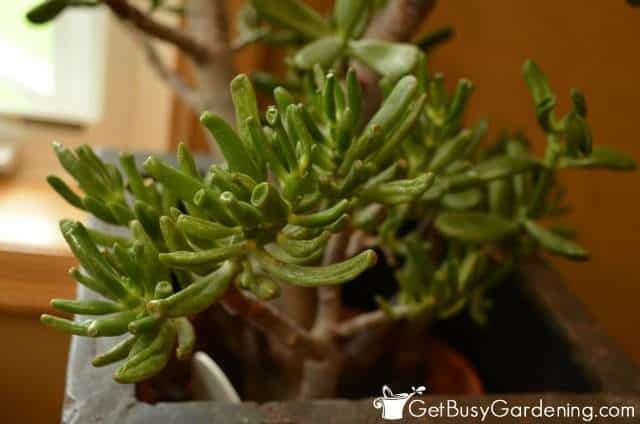
Flowers
Many people are surprised to learn that, with the proper care, jade plants can flower. In warmer climates where they grow outside year-round, they bloom during the winter. But it’s very uncommon indoors without help.
To get your jade plant to bloom, you need to give it similar conditions to what it experiences when it’s outdoors.
The trick is to give it tons of light during the summer. Then, expose it to cooler (but never freezing) temperatures in the fall, and allow the soil to dry out.
When you bring your jade back inside in the fall, put it in a sunny spot, and keep the soil dry. You should start seeing flower buds in a few weeks.
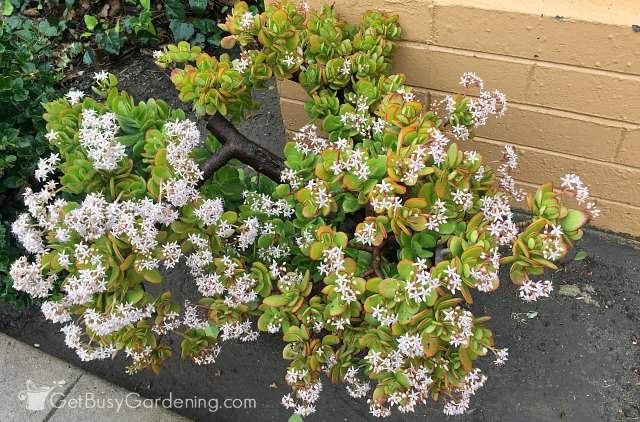
Crassula Toxicity
According to the ASPCA website, jade plants are toxic to dogs and cats if they ingest them.
My cats have never touched mine, but it’s a good idea to keep them out of reach if your pets like to snack on plants, just in case.
Where To Grow Jade Plants
If you live in a warm enough climate, you can grow your jade plant outside year-round. But they also do very well as indoor houseplants.
Hardiness
Jade plants are hardy down to zone 9. They can handle a bit of cold, and are even tolerant of light frost. But they will eventually die if it stays cold for too long.
If you live in an area with harsh winters, then you’ll either need to bring your plant indoors for the winter, or keep it as a houseplant.
Location
The best location to grow your jade plant is a sunny spot with dry soil. Outdoors, plant it in a spot where the ground is very sandy and fast-draining. Indoors grow your potted jade in a sunny, south-facing window.
You could keep it indoors year-round, or put it outside during the summer to give it a growing boost. Just make sure the pot has holes in the bottom, and bring it back inside before it drops below 60°F in the fall.
Related Post: Debugging and Cleaning Potted Plants Before Bringing Them Indoors
Jade Plant Care & Growing Instructions
For the most part, caring for jade plants is easy. But they do have some pretty specific growing requirements. So, for best success, follow my detailed instructions and tips below.
Watering
The biggest mistake that people make with jade plant care is overwatering, and this is their #1 cause of death. Too much will cause root and stem rot, quickly killing your plant.
You can learn exactly how to properly water your jade plant in this guide, but here are a few quick tips:
- Let the soil dry at least 2-3″ deep before giving your plant more.
- When it’s time, water deeply until it starts running out the bottom holes, and let it drain away completely.
- Give your plant less in the winter, and slightly more during the hot summer months.
- If you struggle with getting it right, get yourself an inexpensive soil moisture gauge to make it easy.
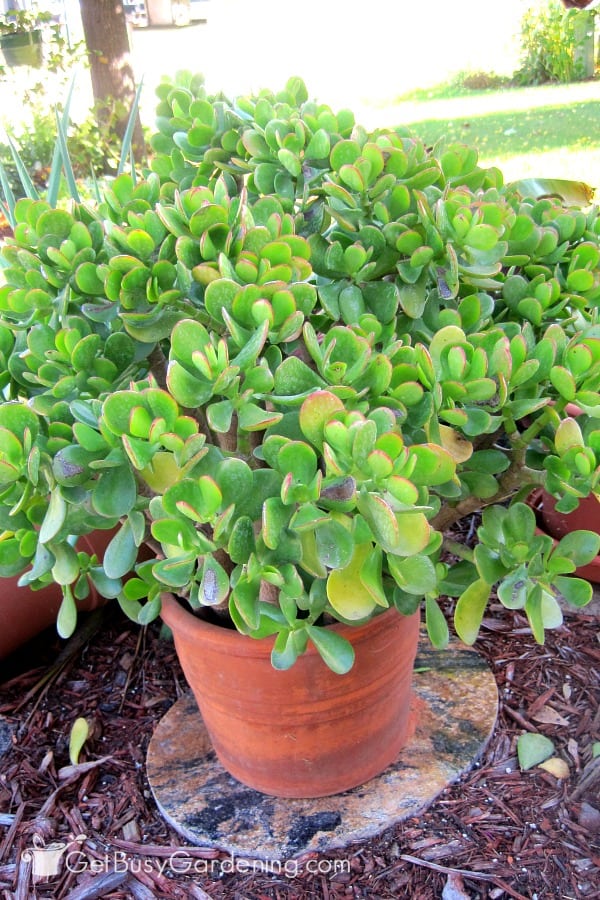
Light Requirements
Though they will tolerate partial shade, jade plants grow best in a full sun location. If it’s too dark, especially indoors, the stems and branches will become weak, thin, and leggy.
With enough sunlight, the stems and leaves will be thick and compact, and the trunk will turn brown and woody at the base. Also, the leaves or tips of your jade plant will turn red, making them even more beautiful.
Here’s are my tips to figure out the ideal amount light for your plant:
- Indoors – Place your plant in a sunny, south-facing window. If you don’t have enough natural sunlight in your house, then add a grow light to supplement.
- Outside – Grow your jade plant in a full sun to partial shade location. If it gets too much shade, then the leaves will stay green and your plant won’t flower.
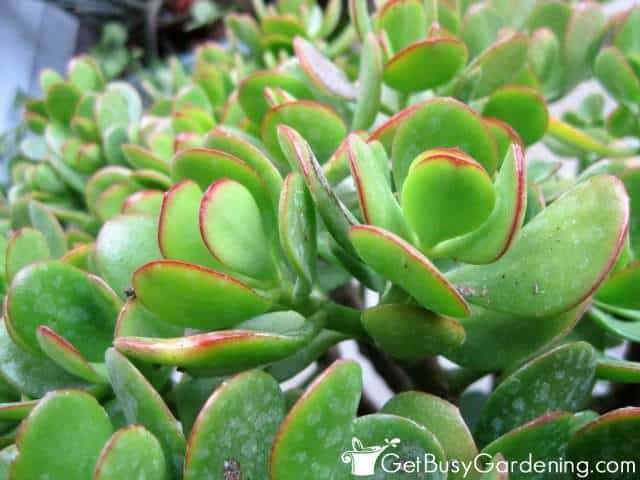
Temperature
Jade plants grow their best when the temps are between 55-85°F. They can handle occasional frost, but they’re not very cold hardy.
They’ll also survive brief periods of freezing temperatures, but will start to suffer if it’s cold for too long. So make sure to protect your plant or bring it indoors if it’s going to stay below 45°F outside.
On the flip side, they can handle the heat in the summer. But the leaves can start to shrivel in extremely hot and dry weather. So you should give your jade a little extra water during extended heatwaves.
Best Soil
Using the correct soil for your jade plant is a crucial part of their care. They need a porous and quick-draining mix. General purpose potting soils hold too much moisture, and can cause your plant to rot.
You can buy succulent soil, get a gritty commercial mix, or you can make your own by mixing coarse sand, potting soil, and perlite.
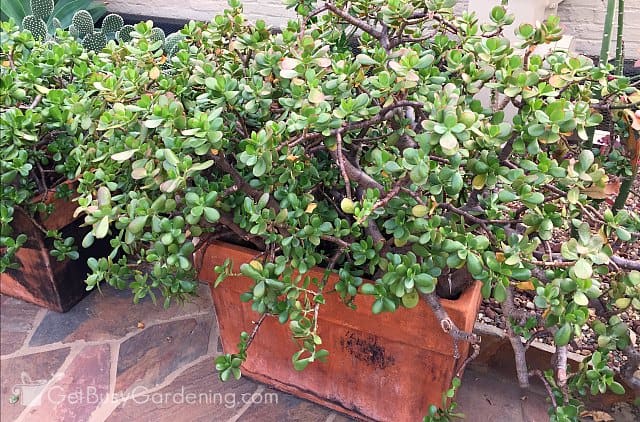
Repotting
Jade plants have very shallow roots, so they can live in the same pot for many years. In fact, it’s better to keep your plant a little root-bound, rather than repotting it too often.
When the time comes, choose a container that is 1-2 sizes larger than the current one. I recommend using an unglazed clay pot, but plastic or another type will work, as long as it has drainage holes in the bottom.
Fertilizer
You don’t need to worry too much about fertilizing as a part of your regular jade plant care routine. But it will help to encourage faster growth and flowers.
Apply a general purpose liquid monthly during spring and summer, or top-dress with slow-release granules once or twice.
Jades go into a dormant state during the colder months, and you should let them rest. So don’t fertilize during the fall and winter, or the new growth will probably be weak and leggy.

Pest Control Tips
Healthy jade plants don’t usually have problems with pests. But sometimes mealybugs, scale, or spider mites can attack them, especially indoors.
You can spot-treat small infestations by soaking a cotton swab in rubbing alcohol and using that to remove the bugs. For a larger or persistent outbreak, treat your plant with neem oil or a insecticidal soap.
Jades can be sensitive to some types of sprays though. So test any product that you want to use on a couple of leaves first to make sure there’s no damage before you treat the whole plant.
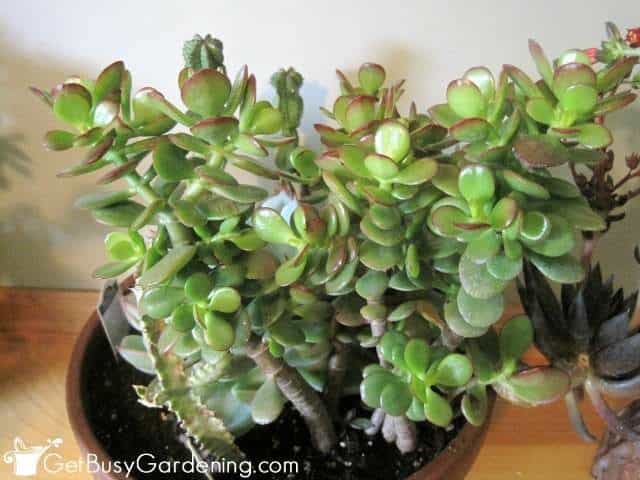
Pruning
Regular pruning is another important part of jade plant care. It will help to keep the foliage compact, and encourages the stems and the trunk to grow thicker.
Pinch off the new tips as they form in the spring or early summer, and use a sharp pair of precision pruners to trim leggy growth and encourage branching.
Get my full step by step instructions for when and how to your prune jade plant here.
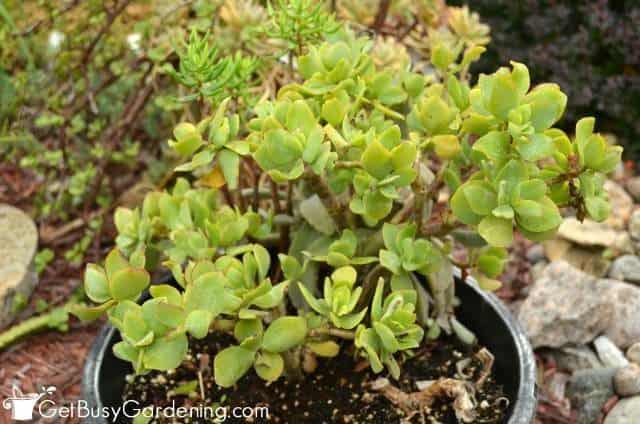
Propagation Tips
Jade plants are extremely easy to propagate, and you can grow tons of new babies by rooting either stem or leaf cuttings.
Allow the cut area to dry for a few days, then dip it in rooting hormone. Plant it in a slightly moist, well-drained soil mix, and in a few weeks it will form roots.
If you want to learn more about how to do it, then check out my detailed step-by-step jade plant propagation instructions here.
Troubleshooting Common Problems
In this section, I’ll help you troubleshoot some of the most common jade plant care problems you may have, with tips for how to fix them.
Leaves Or Branches Falling Off
When the leaves or branches start dropping off, it’s almost always caused by improper watering (usually too much), but it could be from a bug infestation.
Inspect your plant for signs of bugs, and treat any that you find. Ensure the soil dries completely before giving more, but never to the point where the leaves start shriveling or the plant droops. Use a moisture gauge to get it just right.
Mushy Or Rotting Stem Or Leaves
When the stem, branches, or leaves are brown and mushy, then it means they are rotting because of excessive moisture.
If they’re rotting on the top of your jade plant, then you can just prune off the affected parts. Otherwise, if the main stem is mushy, then you’ll have to take healthy cuttings to start new plants.
Leaves Turning Brown
This could be caused by improper watering or sunburn. If the brown leaves are soft and mushy, then they’re rotting from overwatering. Otherwise if they’re dried up and crispy, then your plant isn’t getting enough moisture
Ensure you’re giving your jade the correct amount of moisture, and harden it off before moving it into the full sun to prevent burning.
Trunk & Stems Turning Brown
It’s normal for the main trunk and branches to turn brown and become woody with age, and it means that you’re doing a great job of caring for your jade plant. However, if smaller stems suddenly turn brown after moving them into the direct sun, it is from sunburn.
In that case, move your jade back to the shade, and slowly acclimate it to the full sun over a period of a few weeks.
Shriveling Or Drooping Branches Or Leaves
When the leaves or branches shrivel, that usually means your jade plant isn’t getting enough moisture.
However, it can also be a sign that the stem has rotted. If the base is not mushy, then water your plant more often. Otherwise, treat it for rot.
Roots Growing On The Stem Or Branches
When roots grow on the stem or branches, they are called “aerial roots”. Though it’s not always a problem, this can be triggered by under watering, and also happens when the main stem is rotting.
Ensure your jade is getting enough moisture, and check the entire stem for signs of rot. If all is good, then you can just prune off the stems with aerial roots if they bother you, or leave them be.
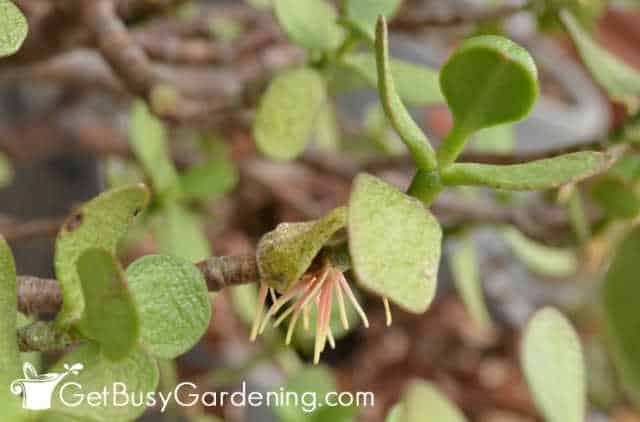
FAQs
Below I will answer some of the most frequently asked questions about growing jades. If you can’t find the answer to your question here, ask it in the comments below.
Is a jade plant indoor or outdoor?
You can grow jade plants either indoors or outdoors, depending on where you live. They aren’t cold hardy though, so you must move them indoors in freezing weather (anywhere less than zone 9).
Do jade plants go dormant?
Though jade plants don’t go fully dormant, they do go into a resting state in the cooler winter months. During this time, growth will slow, and they don’t require as much water.
Does a jade plant like to be root-bound?
Yes, jades like to be root-bound, and can live in the same pot for many years. Their root system isn’t very large, so keeping them in a smaller pot will help prevent overwatering.
Jade plants are easy to care for, and beautiful too. If you follow my detailed tips in this guide, you’ll have no problem keeping yours growing and thriving for decades to come.
If you want to learn all there is to know about maintaining healthy indoor plants, then you need my Houseplant Care eBook. It will show you everything you need to know about how to keep every plant in your home thriving. Download your copy now!
Share your jade plant care tips in the comments section below.


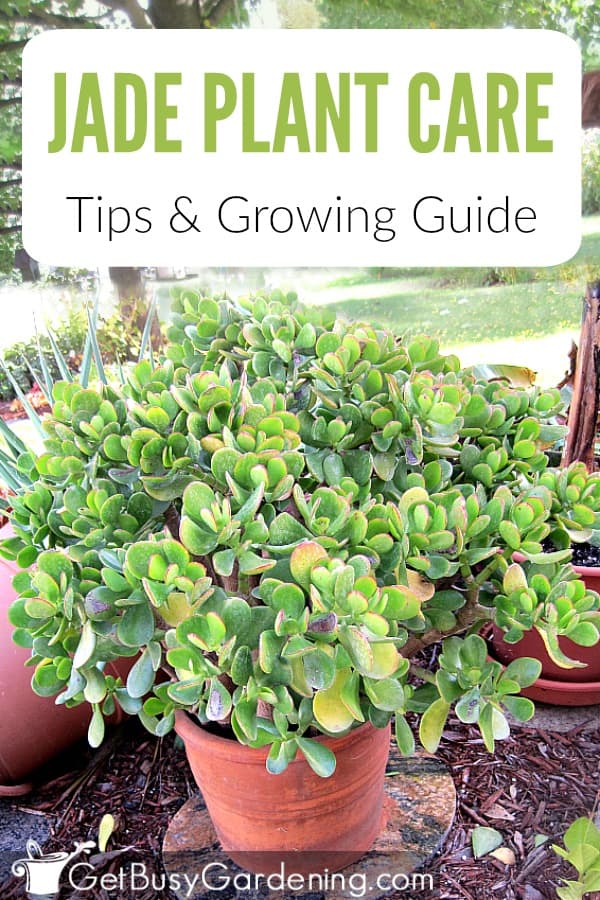
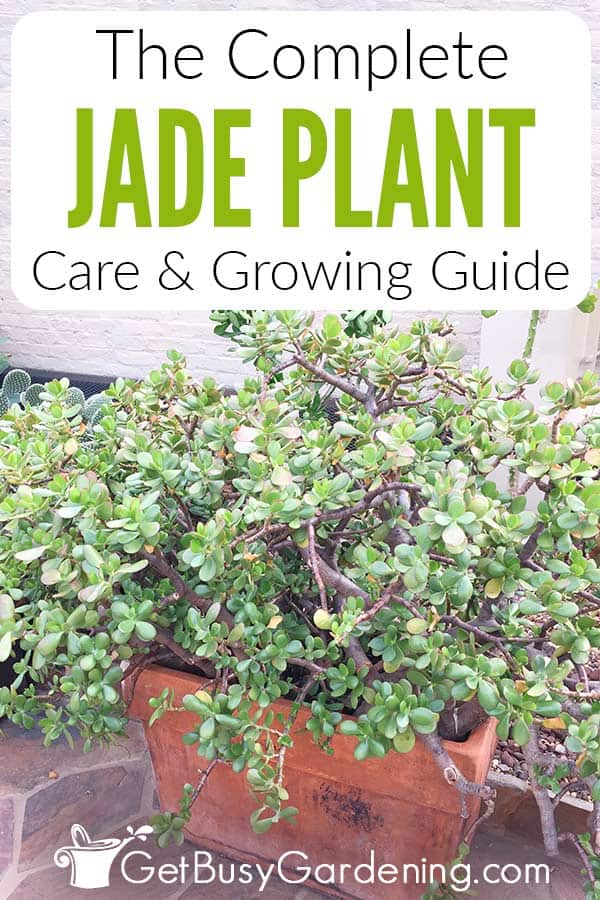
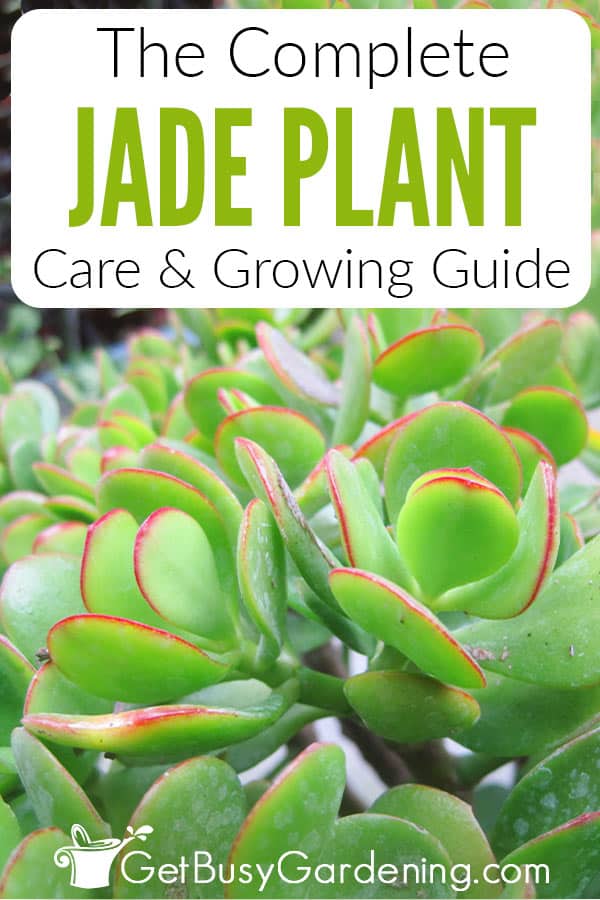
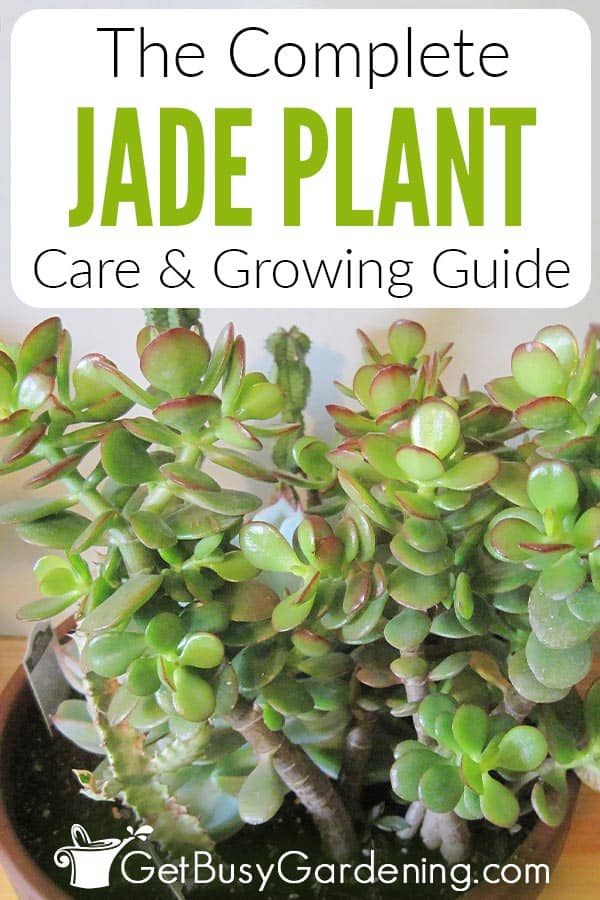
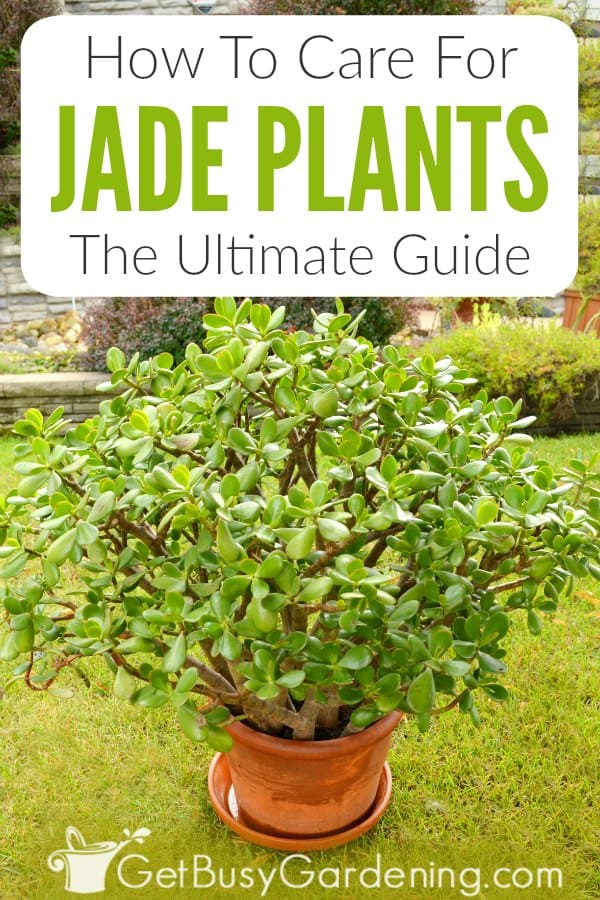
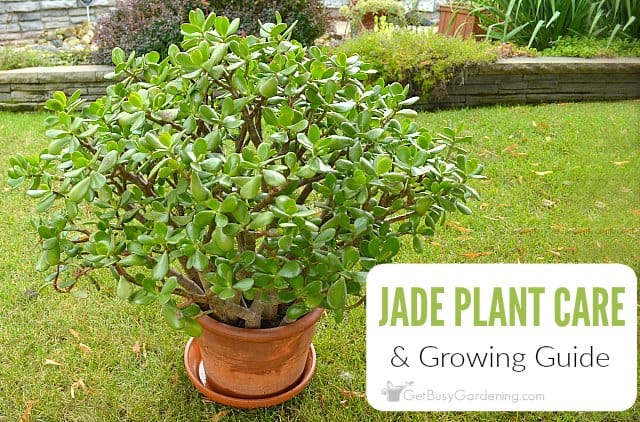




ruby says
Hello! I have learned a lot of problems/solutions/suggestions/info from my fellow succulent lovers especially jade plants by reading all their comments. I am a beginner to the succulent world and I want to thank you because it seems that you are the only one by far who respond to the questions succulent lovers ask. In fact I am saving this page. I attended a tutorial on growing succulents and there was not much about jade plants.A big THANK YOU from my tropical country, the Philippines.
Amy Andrychowicz says
Wow, you’re welcome! Thanks for taking the time to leave such a nice complement. 🙂 Good luck with your jade plants, I hope they will grow very well for you!
Lilly Coburn says
I recently got a jade plant that is the miniature type you wrote about. It’s stems are a bright red color and some leaves are turning red on the underside. Is this good or bad?
Amy Andrychowicz says
That’s great! When jade plant leaves turn red, it means the plant is happy and getting plenty of sun. Enjoy the beauty of the red leaves.
Lilly says
Is it still good if the actual stems are red?
Amy Andrychowicz says
As long as the plant looks healthy, and the stems and leaves are firm, then all is good. I’ve never noticed the stems on my jade plant turning red, but you might have a different variety than I do.
Terry Lee says
The red you see on your jade plant is like a sun tan rather than a sun burn. It protects the jade from burning in direct sunlight. Be sure to acclimate your jades to the sun gradually over a few weeks. Start under a shade tree and gradually move outward. If you have no shade trees. A small umbrella works great.
Avinash says
Hai
My Jade plant is dying. I don’t know what to do.
Can u please guide me to save the plant.
Amy Andrychowicz says
Sorry to hear your jade plant is sick. Can you give details of what’s wrong with it?
Deb says
Oh, my deck gets east light and some early south light and it seems to love it. Like I said it works for me and my beautiful Jade.
Deb says
Hi I live in the North East of the country. I have always grown Jade plants indoors. 2 years ago my plants looked horrible, one of them died, I think I probably overwatered it. So I moved the pot outside in the winter, with the intention to throw it when I planted my herbs. To my surprise some of the leaves that had fallen off the plant started to grow. Some that had fell on the deck, to my surprise actually had roots, several leaves and small new leaves. Now this was in the spring after the snow had melted. SO I transplanted it with the plant that was still alive and set it outside for the spring through late fall. My plant not only grew included those leaves that fell off on the surviving plant and (I just stick them back into the dirt) it is healthy and beautiful. I do bring it in if we are supposed to get heavy rains. Come spring my plant goes back out onto the deck. When I transplant I mix a little sand with potting soil for more drainage. Works for me.
Amy Andrychowicz says
Awesome! How exciting that your jade plant decided it wasn’t quite ready to die yet. LOL! Thanks for sharing your story and your tips.
Sandra says
Hi! Thanks for the post! I have never had a jade plant bloom. I have several of them I can’t wait to give it a try this year!
Amy Andrychowicz says
Awesome, hope it works for you! 🙂
Erlene Amat says
I haven’t seen a jade plant since I left Hawaii. These grow pretty easily there and was a plant that a lot of people had.
debrashoppeno5 says
I have been very lucky with my jade plant. I got it years ago as a small plant and kept repotting it. Now it is in a large pot and is huge. I never knew how to care for it. Now that I know I will be a better caretaker.
Amy Andrychowicz says
Awesome! It sounds like you’re a natural. 🙂
rash mach says
Please Amy can u tell me if the jade plant is a succulent or a cactus?
Keep up the good work! And good luck!
Amy Andrychowicz says
Jade plants are succulents
Helen Eubank says
Mom had a very old Jade plant that bloomed small white blooms once a year, I think just after Christmas each year. I have small plants now thanks for the tips.
Amy Andrychowicz says
Awesome! Mine have bloomed a few times, but it’s never been covered with blooms. Do you know what she did to get it to bloom every year?
Roberta Wilkes says
I have a jade plant grown from a single leaf about a year ago. It is doing beautifully EXCEPT a grasshopper got into the house and chewed a hunk out of several leaves. The grasshopper was exactly the same color as the leaves so we didn’t see it right away. Should I prune off the entire leaves that were chewed or just trim the damaged part off? The grasshopper just took a hunk out of a leaf and moved to another leaf.
Amy Andrychowicz says
Unless the damaged leaves are showing signs of rot, you can just leave them on the plant. The wounds will heal, and if the leaf is damaged too much, the plant will drop it naturally. But, if it’s bothering you, then for sure you can trim it off (as long as the plant as lots of other healthy leaves). The great thing about trimming jade plants is that they will branch out again at the spot where you trimmed them, making the plant look fuller and more compact.
Amita says
Hi,
Thanks a lot for uploading such nice tips.
I am new to gardening, so i really dont know how to take care of plants. Recently i fell in love with growing succulents at home and i bought one jade plant and also one gollum.
I used to water them once week and that was when i realised that the jade plant had started shedding its leaves and the roots were rotting. My mother suggested me to repot it and reduce watering. I did that and the leaves still keep shedding drastically. I live in dubai and its summer here. I keep my plants in my living room near my balcony so that my plants get ample indirect sunlight. I dont keeo them outside because the heat is not bearable at all.
Now my jade plant has just 2-3 leaves left and i feel very desperate.i just spray some water once in 3-4 days. And i was also trying to propogate these leaves as told above but they turned out to be a flop.may be because i have gone wrong somewhere.please do give a suggestion asap.
Waiting eagerly.
Amy Andrychowicz says
Oh no, sorry to hear that your jade plant isn’t doing well. Check the stem of the plant to see if it’s mushy. If it’s mushy, that means it’s probably rotting and can’t be saved. Also, you won’t be able to propagate the cuttings if they are already rotting. 🙁 Take some cuttings and see if the stem is green inside. If it is, you might be able to propagate it. Just make sure to allow the cutting to cure (dry out) for a few days before trying to propagate it. Don’t water the cutting at all until you see signs of new growth. (you can mist it once and a while, but at most once a week). Good luck, hope your plant will survive!
Charlene Durham says
Hi. I have an e.t. finger jade plant that is turning yellow at the bottom and then brown then that part will fall off. I let it dry out between waterings. There is a drain hole in the bottom of the pot, it gets plenty of sunlight inside (it has been 95-100 degrees here all summer so I don’t put it outside). Any tips to help? Thanks and may God bless.
Amy Andrychowicz says
When you say it’s turning yellow at the bottom, do you mean the base of the plant or the bottom of the leaves? Check the stem to make sure it’s not soft.
Janet says
Hi, I have a jade plant that I grew from a leaf, it is now about 2 foot tall. It sits on my kitchen window, that is south facing and was fine until a few months ago. I have noticed that it is covered in black spots, any ideas? It has been very cold this winter, could this be a problem? I would hate to loose it, I have started a few new ones just in case, but really want to save this one.
Amy Andrychowicz says
I suspect that you might be overwatering your jade plant. Jade plants need hardly any water during the cool winter months, and overwatering them during this time is one of the main causes of black spots on jade plants (I water my large jade plant maybe 2-3 times through the entire winter). Allow the soil to dry out completely before you water the plant again. Also, be sure the pot you’re using has drainage holes and allow it to drain completely each time you water – never allow the plant to sit in water. Also, take a close look at the plant to be sure it doesn’t have any bugs. Bugs could also cause black spots on jades. Be sure to look under the leaves and in the leaf joints.
Terry Faulkner says
I have been taking cuttings from my Jade plant for Agee years now and I must have 40 or more. I have the luxury of living in Northern California where I can plant them outside in the ground. In the 40 years that I have grown Jade plants, I have never had a problem with one rotting as you describe. However, succulents in general often react to overwatering, bad soil and not enough light by rotting. When they reach a certain point, you can’t bring them back except by taking cuttings.
Always allow the soil of your jade plants to dry out between waterings. The reason for this is the roots of Jade plants and most succulents need air to reach their roots. This can only happen if the soil dries out. You can add sand to your soil so water will pass through it faster also.
Instead of fertilizing my plants I have a compost bin which supplies me with enough compost to mix into the soil of my Jade plants.
Amy Andrychowicz says
Wow, I didn’t realize you could grow jade plants outside year round in NC! That’s awesome!
Harinder Sidhu says
Thanks for so much good information on Jade plants and watering. I think i have been watering my Jade plant too much and the plant is sitting in a another planter without drain holes. There are leaves that are burning off. I contributed this to too much direct heat.
I like to make sure i don’t kill my Jade plant and would like to understand few things:
1. How much heat is too much for jade plants, i live in Bay Area, CA and heat in summer can get to 100 FH.
2. Can the plant be left in direct heat?
3. How much cold is too much? Cold here can be as low as 30 FH.
4. Can i plant it in the ground and cover it during winter to protect from cold? I see that Terry has successfully planted in the ground and would love to understand how she is able to do that.
Amy Andrychowicz says
It sounds like maybe you move your jade plant into the house during the winter, and then grow it outside during the summer? If that’s the case, then you have to make sure to move it into the sun gradually or the leaves will burn. Once it’s used to being in the sun, then it should be kept growing in full sun. Jade plants love sun and heat.
1. Jade plants can take the heat, I’ve seen them growing as shrubs in Southern CA, and areas of NV and AZ during my travels.
2. Yes, they should be grown in full sun
3. As for the cold, they are hardy down to zone 9a, so they can take a bit of cold.
4. Yes. As I said, they are grown as landscaping shrubs in other areas of CA. So, if you live in an area that is in growing zone 9a or higher, then you can plant them in your garden (just be sure to acclimate them to the full sun (i.e.: harden them off) before you plant them in your garden).
Rebecca says
I love jade plants, and we are very fortunate to have our side hill covered in a jade forest that the previous owners must have planted decades ago. You are right that they don’t need much water. We rarely, if ever, water them and they are thriving. They are in bloom right now, hundred of tiny white flowers, and it’s beautiful. Thank you for al the tips and suggestions. I’ve wondered why our jade plants don’t get red on the tips, and it must be because they are on a north-facing slope. I will have to try planting a few in a sunnier location.
Amy Andrychowicz says
That sounds amazing! You are so lucky to be able to grow them outside in the landscape! Yes, it would be fun to see how differently they grow in full sun, jade plants do prefer the sun. Mine just flowered for me this year for the first time ever. There were only a few flowers, but it was so cool to see them blooming indoors like that!
Kim~madeinaday says
I loved my Jade plant, unfortunately I had to leave it behind when we moved across country! It was huge!
Amy Andrychowicz says
Oh man, that must have been hard! But now that gives you an excuse to get a new one, right? 😉